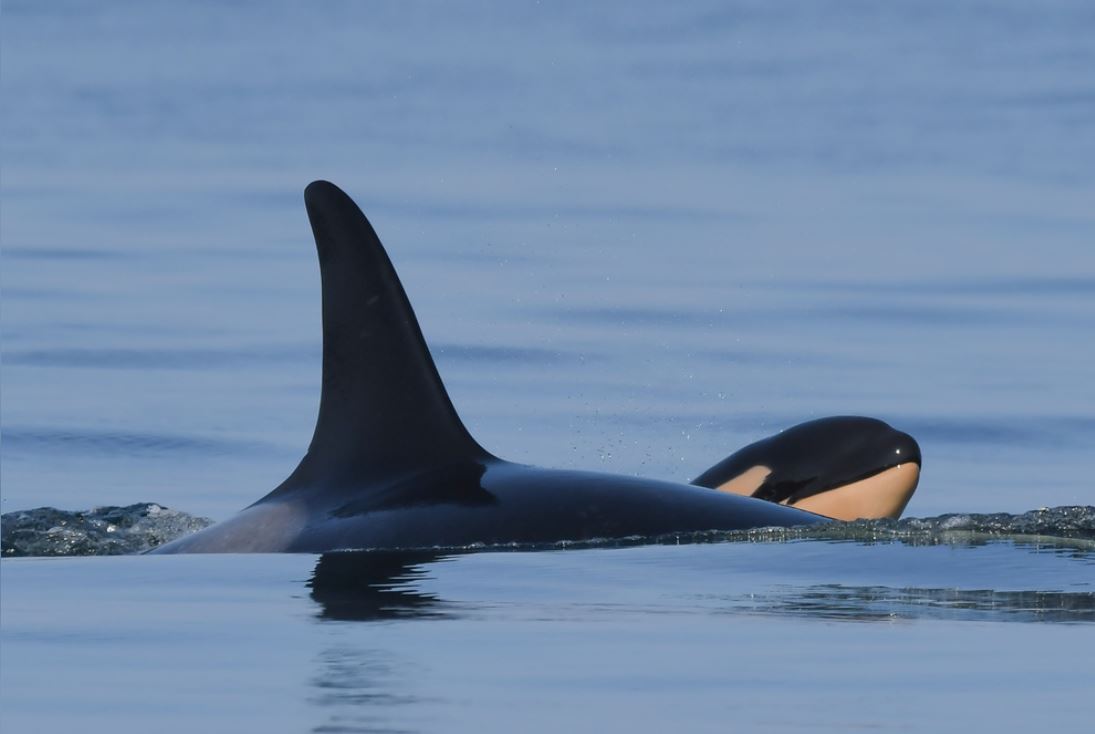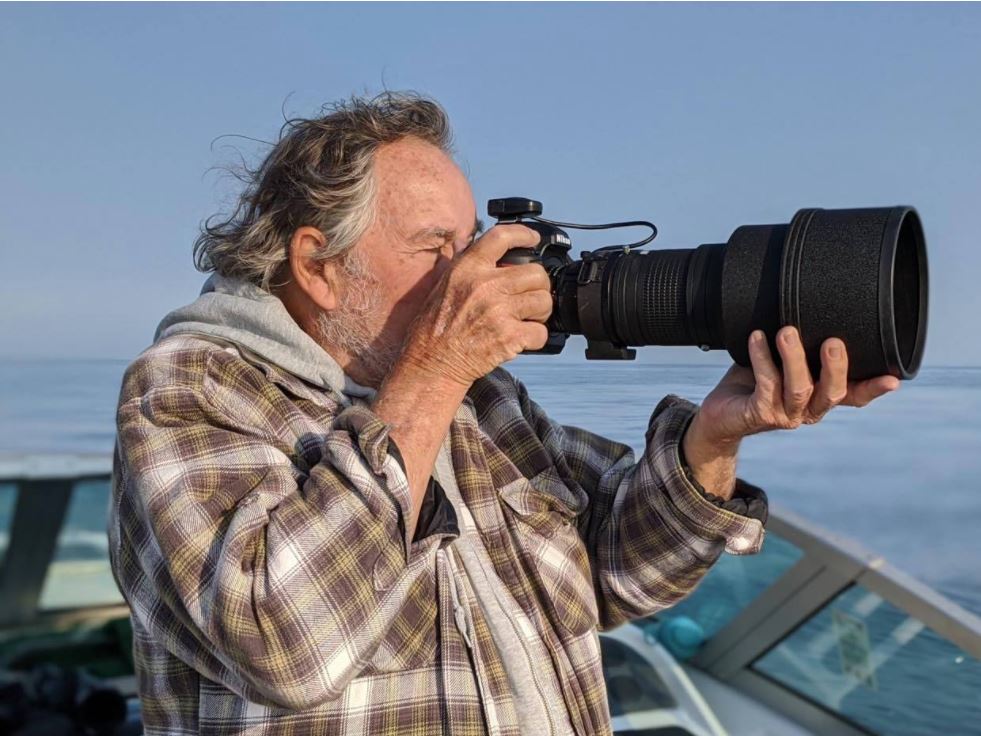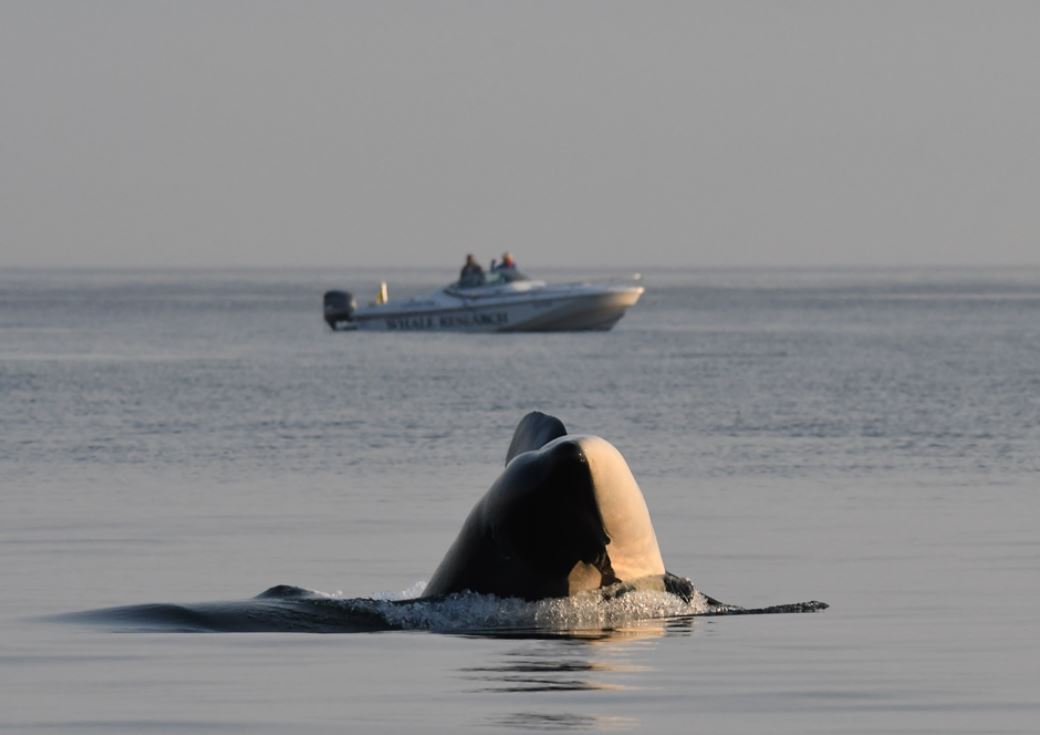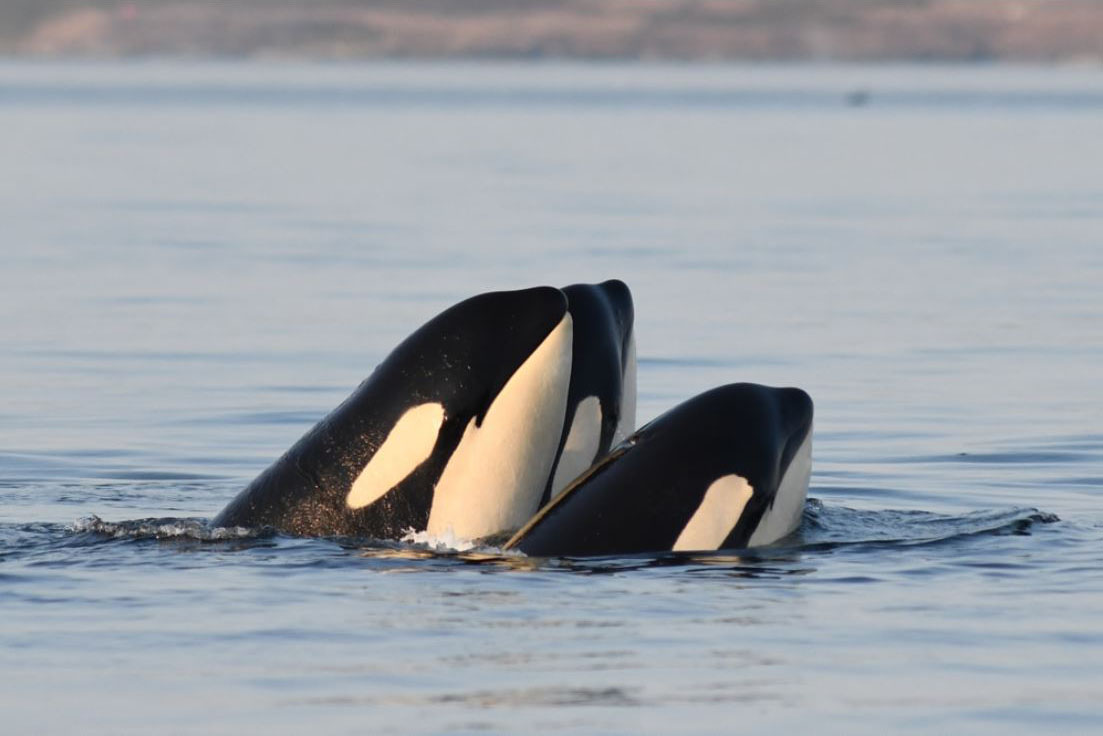||| from Lodie Gilbert Budwill, Community Relations Coordinator |||
September 5, 2020.
The day started out hazy with a lot of chop on the water. Visibility was poor for sighting whales from my location at Eagle Cove facing south. If it weren’t for a distant breach, followed by a large male dorsal fin poking up above the whitecaps, I wouldn’t have known the whales were around.
I messaged Ken Balcomb, Center for Whale Research Founder and Senior Scientist at 7:45 AM to let him know that an adult male was offshore of Granny’s Cove headed south, and I could see more whales far offshore, near Hein Bank. Ken answered back, “Weather is not good for an encounter yet. Maybe in a few hours.” Conditions were far from ideal to spot whales, and even worse to be on the water, so the plan was to wait until the seas calmed down. Meanwhile, reports rolled in of K Pod and L Pod nearing Race Rocks heading inbound. Was this going to be a long-awaited Superpod?
The next message I received was: “Estimating 1400 departure from Snug Harbor, maybe sooner.” The conditions had greatly improved. The water had gone from dark and rough, to flat and glassy. I loaded up my gear and met Ken at Snug to depart on Chimo. This was my first time on the water with Ken aboard Chimo, but I had heard many stories over the years about how the whales recognize and behave around his boat. I was beyond excited to experience this day!
We departed the dock at 2:30 PM and headed southwest toward Hein Bank, careful not to cross the US/Canadian border. We had a long distance to go, but Chimo really glides over the water. As we drew closer, we could see activity in the distance. Katie Jones was onboard the CWR research vessel, Orcinus, and phoned to let us know their location. She shared the news that she and Dave Ellifrit were viewing J35 and her newborn calf. I saw a worried look come over Ken’s face for a split second, that turned into a big warm smile as Katie shared with him that all looked good.
Upon our arrival, the whales were spread across the border in social groups: some on the US side, some still in Canadian waters. Ken spotted J35 and her calf from a distance and took photos with his telephoto lens. He commented while photographing, “Looks like a healthy and precocious baby.” The calf was swimming next to J35’s side. It was a beautiful sight, mother and baby, both swimming.

J35 with calf, J57 (Photograph by Katie Jones, CWR)
After sighting J35 with her calf, it was time to photo document as many whales as possible for Orca Survey ID. I could tell that Ken was determined to accomplish this task. This was the first Superpod of the year and a good opportunity to ID whales that hadn’t been sighted in US waters since last year.
Ken positioned Chimo, and we sat still in the water, observing whales off in various directions. The water was flat and glassy as he waited patiently and knowingly with camera in hand. Suddenly, off the boat’s starboard side, a large group of whales exuberantly burst through the surface with loud exhalations. Then they abruptly stopped and remained at the water’s surface, gliding toward the boat until they were just a few yards away. They held in logging position with their rostrums pointing to the bow of Chimo. The female whale in the lead started vocalizing above water. This made Ken giggle, and I couldn’t hold back an “Awwww!” They stayed next to the boat positioned at the surface like this for several minutes. Ken photographed while I took video. I felt like I was witnessing a greeting ceremony between the whales and Ken!!!

Center for Whale Research Founder and Senior Scientist Ken Balcomb photographing whales during the September 5, 2020, Superpod encounter (Photograph by Lodie Gilbert Budwill, CWR)
The encounter continued for several hours with Ken capturing ID photos of various individuals needed for Orca Survey. The whales continued to socialize close to the US/Canadian border like it was one big playground. When the time came, Ken said, “Okay, we’ll leave these guys here now. It’s time to head home.” As sad as I was to have to leave the whales, I was filled to the brim with gratitude and happiness for having such an incredible experience!
Ken started to slowly motor away. As he did, I noticed the whales we had been with also turned and were pointing toward the back of Chimo. Ken gradually increased speed and headed for home with his eyes on the horizon. I kept my eyes on the whales that we were leaving behind … or I thought we were leaving behind! HA! They were definitely following the boat! I tugged on Ken’s flannel sleeve, “Ken, the whales are following you!” … “Yeah, they do that sometimes” … “Ken, the whales are porpoising now, I think they’re trying to catch up to you!” He laughed a jolly laugh! Eventually, they caught up to Chimo and were paralleling both sides of the boat, porpoising, high-speed rolling, twirling, and a few on-the-move breaches. When Ken would slow down, they would slow down, and when he would speed up, they would speed up. I asked Ken if he always has whale escorts on his way home, he replied, “Yeah, sometimes, it makes it hard to get home”!

Ken Balcomb and Lodie Gilbert Budwill aboard Chimo documenting the SRKW behaviors (Photograph by Katie Jones, CWR)
After several miles of breathtaking travel with escorts off both sides, Ken stopped the boat. The whales stopped too. They moved in front of Chimo, just a short distance off the bow, and then engaged in a roly-poly, cuddle puddle. At this point, I was taking video with my jaw dropped to the floor! There are no words to fully describe this experience (the video below provides the visual). It was like a love-fest of tactile behaviors at the surface of the water. We witnessed whales spy-hopping in unison, three and four at a time while cheek to cheek, rolling and twirling, pec-slapping, tail-lobbing. I felt like I was dreaming!
We were starting to lose light, and it took longer to get home than expected, but it was the experience of a lifetime! We started the encounter with the joy of J35’s newborn baby, followed by an incredible, long-awaited Superpod with members from all of J, K, and L pods.
But I will never forget the experience of being on the water with Ken, the greeting we received upon arrival, and the escorted travel home. It felt totally surreal, yet it was so real!
There is no doubt in my mind that these whales recognize, respect, and enjoy Ken’s company on the water. He has dedicated his life to them as an advocate — a voice for the whales — documenting their existence, their births, and their deaths for over 44 years.
Thank you, Ken Balcomb, you are a legend.
**If you are reading theOrcasonian for free, thank your fellow islanders. If you would like to support theOrcasonian CLICK HERE to set your modestly-priced, voluntary subscription. Otherwise, no worries; we’re happy to share with you.**









Lordy, we gotta do better by these incredible creatures. Wish every sentient human could watch this video.
Give them a chance, some quiet, and some space, and they’re back!
Thanks so much for sharing your incredible experience. So very beautiful.
Listen to what Lodie is saying and showing us…there is true communication between us and other sentient creatures….we just have to open our heart space and listen. Our rational minds get in the way, but other creatures don’t have that trouble.
Our resident Orcas have known Ken for many years, and are honoring him with their thanks and attention.
p.s. Lin, I like that the video repeats, unbidden. I could watch it for hours.